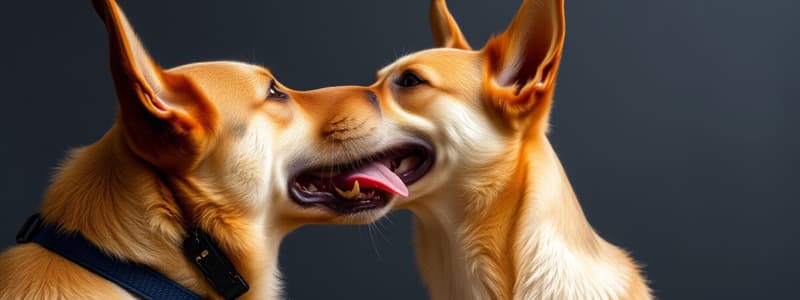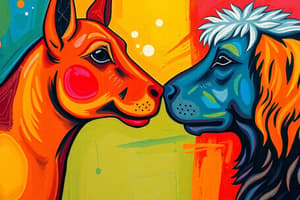Podcast
Questions and Answers
What is Pavlovian conditioning?
What is Pavlovian conditioning?
It is also known as Classical Conditioning and is a Stimulus-to-Stimulus Learning. It is one of 2 types of associative learning. The other is operant conditioning.
What are Pavlov's 2 types of reflexes?
What are Pavlov's 2 types of reflexes?
- Conditioned reflexes
- Learned reflexes
- Psychic reflexes (correct)
- Physiological reflexes (correct)
What are physiological reflexes?
What are physiological reflexes?
Invariable reflexes shown by all animals of a different species, intrinsic to the innate organization of the nervous system.
What are psychic or conditioned reflexes?
What are psychic or conditioned reflexes?
What is an Unconditioned Stimulus (US)?
What is an Unconditioned Stimulus (US)?
What is an Unconditioned Response (UR)?
What is an Unconditioned Response (UR)?
What is a Conditioned Stimulus (CS)?
What is a Conditioned Stimulus (CS)?
What is a Conditioned Response (CR)?
What is a Conditioned Response (CR)?
What is a trial in Pavlovian conditioning?
What is a trial in Pavlovian conditioning?
In Pavlov's dog experiment, the US is ______, the UR is ______, the CS is ______, and the CR is ______.
In Pavlov's dog experiment, the US is ______, the UR is ______, the CS is ______, and the CR is ______.
In the McDonalds example of Pavlovian conditioning, the US is ______, the UR is ______, the CS is ______, and the CR is ______.
In the McDonalds example of Pavlovian conditioning, the US is ______, the UR is ______, the CS is ______, and the CR is ______.
What are the two basic requirements for a stimulus to function as a Conditioned Stimulus?
What are the two basic requirements for a stimulus to function as a Conditioned Stimulus?
What are the two differences between the Conditioned Response (CR) and the Unconditioned Response (UR)?
What are the two differences between the Conditioned Response (CR) and the Unconditioned Response (UR)?
Explain the S and R in the Rabbit Nictitating Membrane Experiment.
Explain the S and R in the Rabbit Nictitating Membrane Experiment.
What are the 3 different stages of Pavlovian Conditioning?
What are the 3 different stages of Pavlovian Conditioning?
What happens in stage 1: Habituation?
What happens in stage 1: Habituation?
What happens in stage 2: Acquisition?
What happens in stage 2: Acquisition?
What happens in stage 3: Extinction?
What happens in stage 3: Extinction?
What is re-acquisition?
What is re-acquisition?
What is spontaneous recovery?
What is spontaneous recovery?
Study Notes
Overview of Pavlovian Conditioning
- Also referred to as Classical Conditioning; a type of Stimulus-to-Stimulus Learning.
- One of two associative learning types; the other being operant conditioning.
Types of Reflexes
- Physiological Reflexes: Innate, universal across different species, intrinsic to the nervous system.
- Psychic or Conditioned Reflexes: Learned responses developed through individual experiences.
Physiological Reflexes
- Govern gastric secretion patterns; certain foods trigger specific salivary responses (e.g., thick saliva for food, watery saliva for acid).
Psychic or Conditioned Reflexes
- Develop from personal experiences and are specific to individuals.
Key Terms in Conditioning
- Unconditioned Stimulus (US): Stimulus that naturally elicits a response without prior conditioning (e.g., food).
- Unconditioned Response (UR): Natural, unlearned reaction to the US (e.g., salivation).
- Conditioned Stimulus (CS): Initially neutral stimulus that eventually elicits a response through pairing (e.g., tone).
- Conditioned Response (CR): The learned response triggered by the CS after conditioning.
Conditioning Process
- A trial consists of a single pairing of CS and US.
- Pavlov's experiment used food (US) to elicit salivation (UR) after pairing with a tone (CS), resulting in salivation (CR).
Real-World Applications
- McDonald's Example:
- US is the burger, UR is salivation, CS is the McDonald's sign post-conditioning, leading to CR of salivation.
Requirements for Conditioned Stimulus
- Must be perceptible or attendable by the subject.
- Initially neutral with no biological relevance.
Differences Between CR and UR
- CR occurs before UR;
- CR may be smaller in magnitude compared to UR.
Rabbit Nictitating Membrane Experiment
- US: Air puff to the eye
- UR: Blink/closing of the membrane
- CS (after pairing): Tone leads to CR (eyelid closure).
Stages of Pavlovian Conditioning
- Habituation: CS presented alone prior to conditioning can decrease mean heart rate.
- Acquisition: CS and US paired, which increases mean heart rate over trials.
- Extinction: CS presented repeatedly without US leads to diminished CR; not forgetting but reduced association.
Re-Acquisition and Spontaneous Recovery
- Re-Acquisition: Re-pairing of the CS and US after extinction.
- Spontaneous Recovery: CR returns after re-acquisition, with faster learning observed.
Studying That Suits You
Use AI to generate personalized quizzes and flashcards to suit your learning preferences.
Description
This quiz covers the fundamentals of Pavlovian conditioning, also known as classical conditioning. Review key concepts such as the types of reflexes identified by Pavlov and the principles of associative learning. Perfect for students studying psychology or behavioral science.




